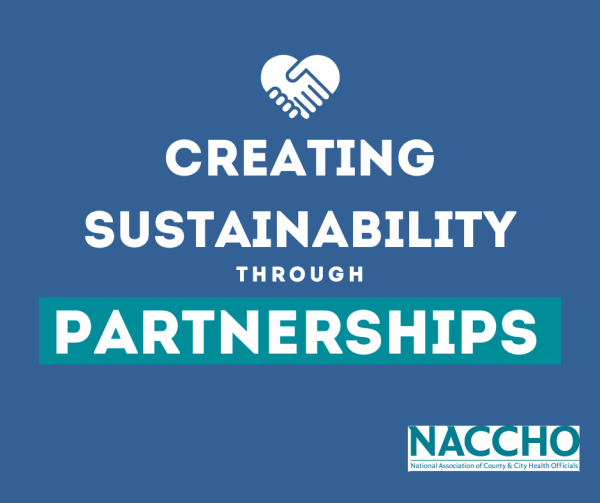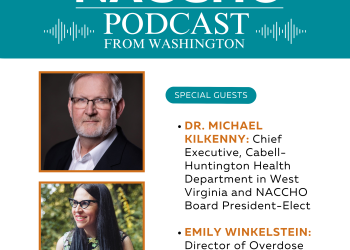Throughout the pandemic, the National Association of County and City Health Officials (NACCHO) collected information from local health departments (LHDs) across the country to learn more about the impact of COVID-19 and the needs of LHDs. This data was compiled and formatted into the COVID-19 Local Health Department database. This database includes information NACCHO received through surveys and other communication channels that detailed LHDs’ needs, efforts, successes, and challenges pertaining to COVID-19 (842 responses). The qualitative data captured was cleaned, coded, and analyzed by NACCHO’s Research & Evaluation team. This data source serves as a repository of information that provides a snapshot of perspectives during the initial stages of the COVID-19 pandemic and shortly after vaccines and other therapeutics became available. NACCHO is using the information collected to better understand what factors are necessary to consider during a pandemic and how to best support local health departments during emergency responses.

A key theme derived from the information collected was the importance of collaborating with partners to encourage the community to get vaccinated against COVID-19. Examples of partnerships highlighted included traditional partners such as schools, health systems, and community-based organizations, as well as non-traditional partnerships like faith-based organizations, pharmacies, libraries, barbershops, childcare centers, and mobile clinics. When building and maintaining partnerships, local health departments mentioned the need to maximize efficiency and meet the needs of communities through mutual decision-making, the ability to be uncomfortable in new collaborations, maintaining like-minded goals, and having a proper understanding of the roles and responsibilities of the parties involved.
Partnerships are vital in creating solutions that are tailored to, and effective in, addressing a community’s needs. Public health has unique partnership needs and throughout the COVID-19 emergency, there were many new partnerships formed – and old partnerships renewed. To continue the progress made at the federal, state, and local levels, understanding the importance of sustaining and developing relationships beyond a public health emergency is imperative. Partnerships during the COVID-19 response provided the opportunity to build trust in communities, maximize resources, and leverage the strengths of different organizations.
Sustainable partnerships are contingent upon effective collaboration between entities. A successful partnership acknowledges that collaboration includes a continuum of engagement that consists of stages, which have specific attributes and requirements. As organizations move from left to right across the continuum, the required levels of time and trust increases. Below is a chart of the continuum of collaboration that can be utilized to build trust and understanding among partners, and how it plays into the success of integrating potential services and programs.

See here for an example from the New York Department of Youth and Community Development displaying how they work with community-based partners across the continuum.

Trust is a key component of successful and sustainable partnerships. Building trust requires actions that are relevant to the partners and stakeholders involved. For example, in examining trust between local health departments and state and federal agencies, all entities must engage in bidirectional communication, share their organizational strengths, and align engagement to represent the mission of their respective organizations. For trust-building between local health departments and federal agencies, it is important for local health departments to receive timely information and resources. Likewise, it is important for local health departments to have the expertise to provide direct care and connection with local communities. For such efforts to be successful, both entities must ensure that communication is transparent and efficient. If vital information is not shared in a timely manner, it cannot be effective in serving communities who need it. Leaning on partnerships and utilizing collaboration efforts allows the opportunity to benefit from partners valuable resources and expertise, as well the opportunity to develop long-term sustainable relationships that can last beyond a project period.
Through the data NACCHO collected, the following guidelines to successful partnerships were identified. These steps help to ensure partners are brought into the work and partnerships can continue beyond a public health emergency. An example of a successful partnership utilized by LHDs and reported to NACCHO are those with pharmacies. Pharmacies expanded their role during the COVID-19 pandemic beyond preparing, dispensing, and administering medications to individuals. Pharmacies collaborated alongside local health departments and healthcare professionals to provide COVID-19 vaccinations and administer COVID-19 tests. During the emergency response pharmacies served as a point of contact and reference to the community by providing health information and guidance, and in some areas providing telehealth services and digital access to communities. Pharmacies were able to meet the needs of local communities and serve as vaccine providers and trusted messengers through direct care and services offered and were able to procure resources from vaccine manufacturers and the federal government. Pharmacies are instrumental in providing access to services and care for local communities, especially underserved communities that have low coverage rates and/or barriers to access.
For each of the steps below (initiation and sustainability), the bullet points represent examples of actions that can occur, as well as factors for success to consider.
Initiation:
- Provide clear expectations in the beginning/planning process
- For relationships built prior to the pandemic and not previously leveraged, rethink partnerships and look to existing partnerships; shifting what is needed based on specific needs/requests
- Increase internal agency partnerships (for example: the health equity team working alongside the immunizations team at the local health department or clinical nurses working alongside EMS) and cross-collaboration between teams
- Hesitant or reluctant partners → build off the strengths and build common ground between partners; provide opportunity and time for more dialogue and clarification about expectations or needs
- Understand the capacity and unique positioning of entities (for example: schools serve as a central part of communities providing care and resources to children)
- Understand the true needs of the community
- Engage partners as soon as possible, before there is an emergency
- Learn from previous mistakes, translate learned lessons into actionable responses
Sustainability:
- Address distrust and mistrust of public health and vaccines from community members → finding trusted partners within the community (whether it be a singular individual like a community activist or group of persons who live and interact with the community, to be a voice of confidence
- Increase longevity beyond an emergency or request of the community → Incorporate other services to meet the needs of the community and continuation of community relationship building
- Continue resources after funding ends → Maintenance and building of proper infrastructure; seek to keep programs and infrastructure in place not only during time of emergency; invest in updated technology and health systems
- Address challenges in communications (information not being shared in a timely manner, internal miscommunication (for example: individuals working on the same thing and not contacting one another, or information being disclosed that was not supposed to) → pre-planning and transparent communication; emphasis of likeminded goals
- Look for ways to retain staff → continue to seek funding opportunities for investment of more staff, contractors, and community health workers; implementation of ways to show appreciation towards staff like mental health days or wellness rooms in-office, understanding the nature of workforce burnout and long work hours
- Show appreciation for efforts → social media posts to highlight partners achievements, agreements to have their information shared at events, vocal appreciation, thank you-cards
- Duplication of efforts → support where needed, don’t interfere if not necessary; advocate for needs of the community and remain optimistic and persistent
Each partnership is different; and what is required will be dependent on the partners involved, their missions and goals, and the objectives of the collaboration. Relationships require time and nurture; and it is a two-way street. It is important for local health departments to be prepared for the next pandemic or emergency, maintenance of routine operations and one way to do that is to continuously look to strengthen existing and new partnerships. Below you will find examples of successes local health departments experienced because of effective and efficient partnerships.
Factors of Success:
- Community-focus
- Data sharing
- Proactive Education
- Reliability
- Appreciation
- Engagement of partners early
- Transparency
- Shared values
- Bi-directional communication
- Humility
- Guidance
- Support between the federal, state, and local levels
At NACCHO, our mission is to improve the health of communities by strengthening and advocating for local health departments. We encourage you to use these best practices that have been constructed based on local health departments feedback to create long-term sustainable partnerships. We encourage continued learning, trust-building, and collaboration efforts to meet the needs of local communities.



